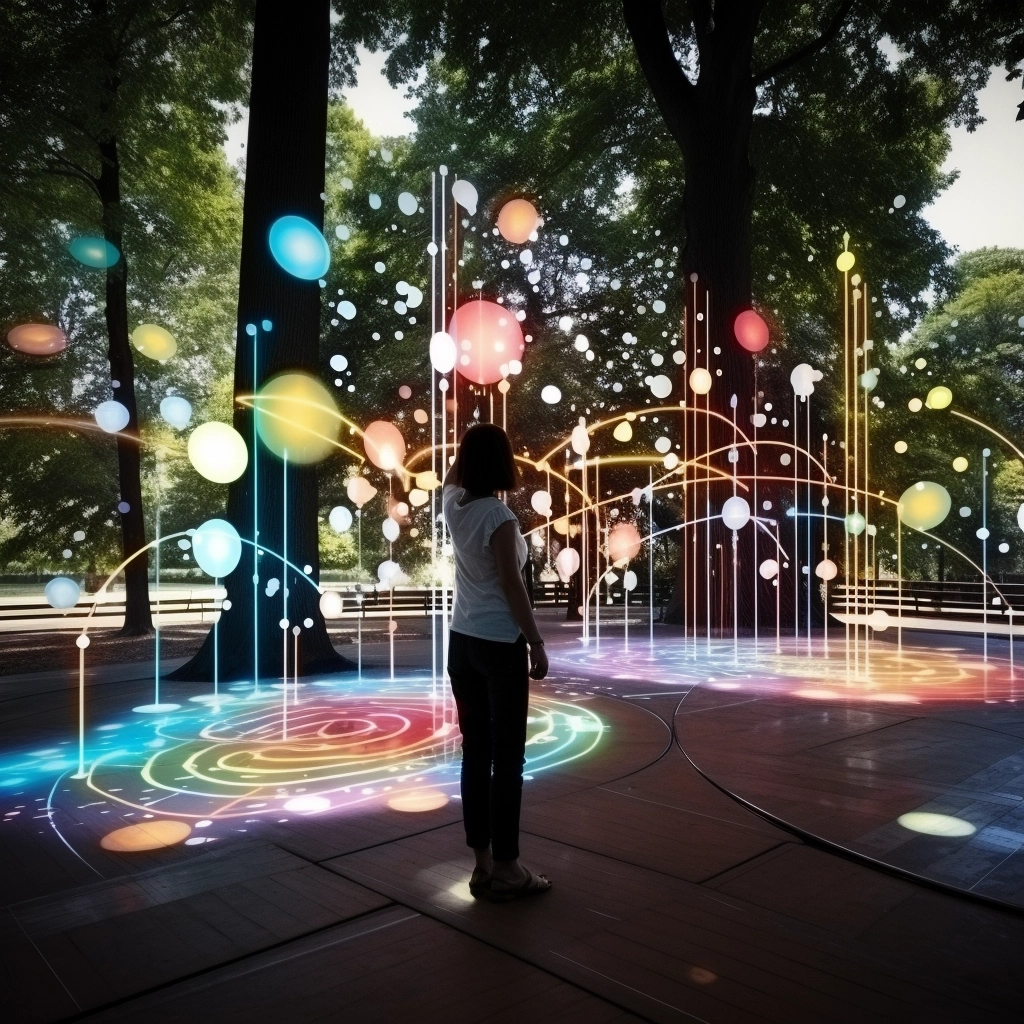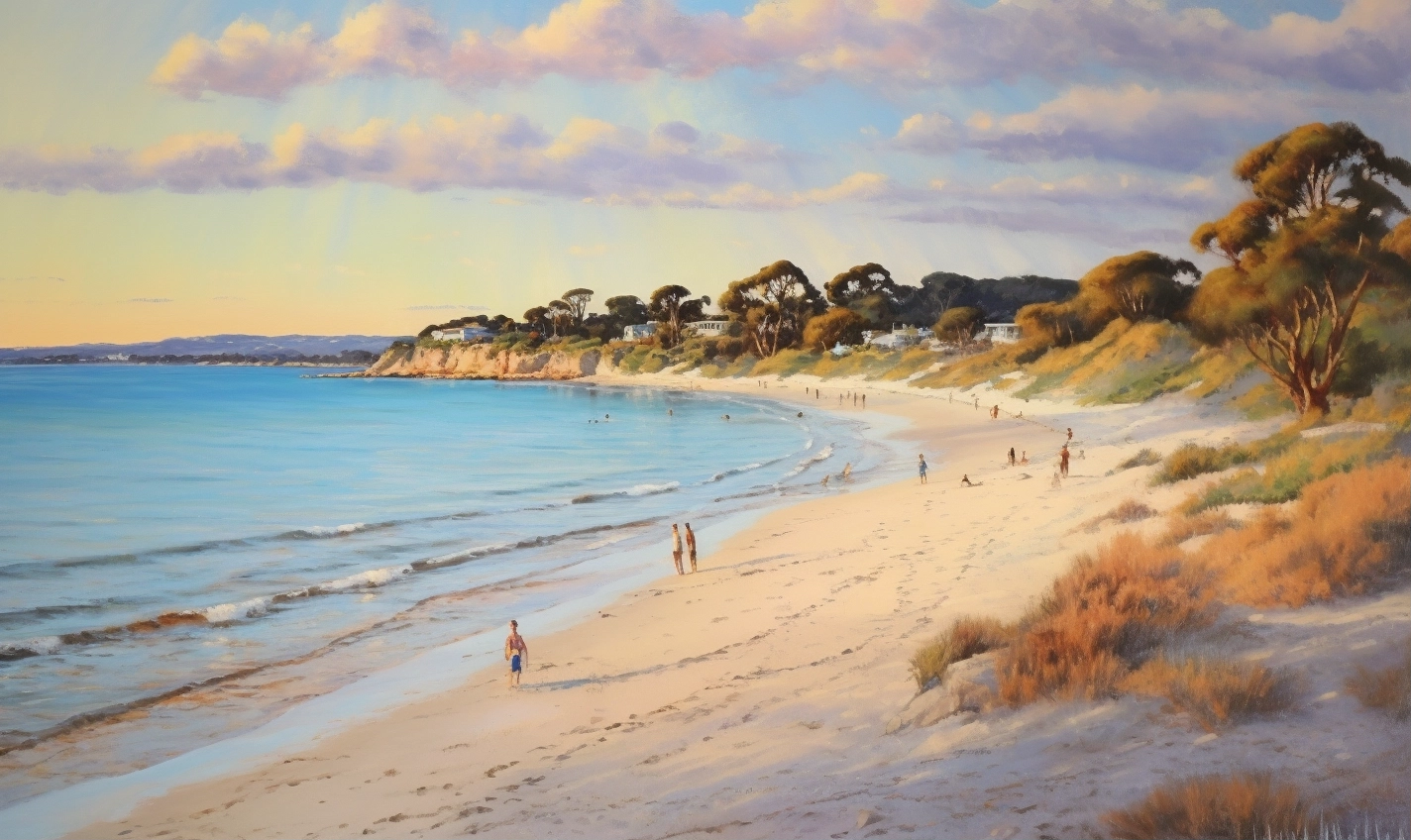Mixed Media Vision: Generative Art through Essentialism at Museums #MixedMedia #GenerativeArt #Essentialism #Museums #xgibson
1. Generative Art Installations
1.1. Artbot
Let me introduce Artbot, an intrepid explorer, venturing into the vast landscape of generative art. This AI system generates texts and images that serve as a springboard for my imagination, driving my artistic expression to exciting new frontiers. Not only a tool but a teacher, Artbot delves into the intricate realms of cybernetics, semiotics, semantics, and syntax. Purposefully crafted to critique and shed light on the future of generative art, it's an enticing partner for artists seeking to decode the complexities and envision the future of artistic expression.
Generate a small Australian impressionist oil painting of Torquay Front Beach using the style of Arthur Streeton at the following time of day Early morning (sunrise) while artistically researching the ideas around Sparkling effects with broken brushwork --ar 5:3 --no text fonts letters watermark words typography slogans signature --v 5.2
2. Generative Print-On-Demand
2.1. Paint Machine
Welcome to the world of Paint Machine, my digital aide-de-camp, working tirelessly to infuse the commercial art space with a fresh vitality. This AI system harnesses the power of algorithms to produce texts and images that resonate with audiences, primed for digital marketplaces and print-on-demand services. As a testament to the fusion of commerce and creativity, it's designed to turn pixels into profits, while stimulating the discourse around the commodification of art in the digital era.
Drawing Machine 2022, Main Screen throughout Archibald Prize Show October 2022, Bunjil Place, City of Casey
3. Computer Vision
3.1. The Drawing Machine
Unveiling the Drawing Machine, a digital artisan that interprets the world through its unique lens. Employing advanced computer vision, it diligently tracks contours, faces, and gestures, overlaying them to construct a deeply layered visual narrative. It's more than just an AI—it's a storyteller, unspooling its yarn on the canvas of technology. This innovative use of AI showcases how the interplay between technology and art can breathe life into static visuals.
Work-in-progress functional prototype, iterating toward a user experience that is intuitive and natural to unlock the latent artistic creativity in every human being.
4. User-Generated Art
4.1. ArtWave
Discover ArtWave, the creative stage where users become the main act. It's an easily accessible online interface that transforms visitors into artists, providing them a palette of AI tools to generate their own masterpieces. Not only a platform but a catalyst, it offers an opportunity to purchase these creations, prompting us to question the traditional relationships between artist, viewer, and collector. ArtWave is an intersection where technology meets creativity, and everyone has a ticket to the show.
In an ever-evolving technological landscape, the advent of AI has transformed art, the quintessential domain of sentient beings, into a realm brimming with exciting possibilities and powerful self-reflections.
In my ongoing creative journey, I've embarked on several art projects with artificial intelligence, unearthing new dimensions of art-making and challenging traditional boundaries of artistic expression. These projects - Artbot, Paint Machine, The Drawing Machine, and ArtWave - encapsulate my exploration of art through the prism of AI. Each one carves out a distinct niche, intertwining the threads of human creativity with the precision of machine learning.
Artbot, my first voyage into AI art, illustrates how generative art explores the intricate semantics and semiotics, pushing the boundaries of what we perceive as art. It creates an environment for artists to critique, understand, and envision the future of art, offering a fresh perspective on the symbiotic relationship between human creativity and artificial intelligence.
Stepping into the realm of commerce, the Paint Machine serves as a testament to the fusion of commerce and creativity. The AI takes on the role of a digital artist, creating compelling texts and images, destined for digital marketplaces and print-on-demand services. It provides a platform to evaluate the intersections of creativity, commerce, and technology.
Next, we have The Drawing Machine, a manifestation of AI as both observer and artist. By tracking key attributes and translating them into a drawn surface, it expands our understanding of the artistic process, blurring the lines between creator and creation.
Lastly, ArtWave represents the democratization of art-making. This platform allows anyone to generate and purchase their unique works of art, questioning traditional roles of artist, viewer, and collector.
These projects highlight a larger narrative about art as a vital activity for sentient beings. Art, in its many forms, is an outlet for self-knowledge and awareness, conduits to higher orders of experience, communication, and understanding. Art does not exist in a vacuum; it intertwines with our identities, helps shape our tribes, influences politics, informs religion, and even defines class structures.
AI, as a collaborator in art creation, underscores our need for these higher orders of experience. By contributing to our creative processes, it prompts us to question and redefine our understanding of art and its influence on our lives. As AI continues to evolve and intertwine with our artistic expressions, it forces us to examine ourselves through a new lens, re-evaluating our perception of sentience in an increasingly digital world.
The interplay between AI and art is more than a merging of two domains; it's a mirror reflecting our sentient selves, an exploration into the depths of our consciousness. It's a testament to the power of art to transcend the boundaries of the canvas and seep into the very fabric of our societies. Whether we're generating art through AI, creating digital marketplaces, or tracking contours with computer vision, every pixel adds to the grand tapestry of human experience, adding to our collective narrative as sentient beings in an ever-evolving world.





